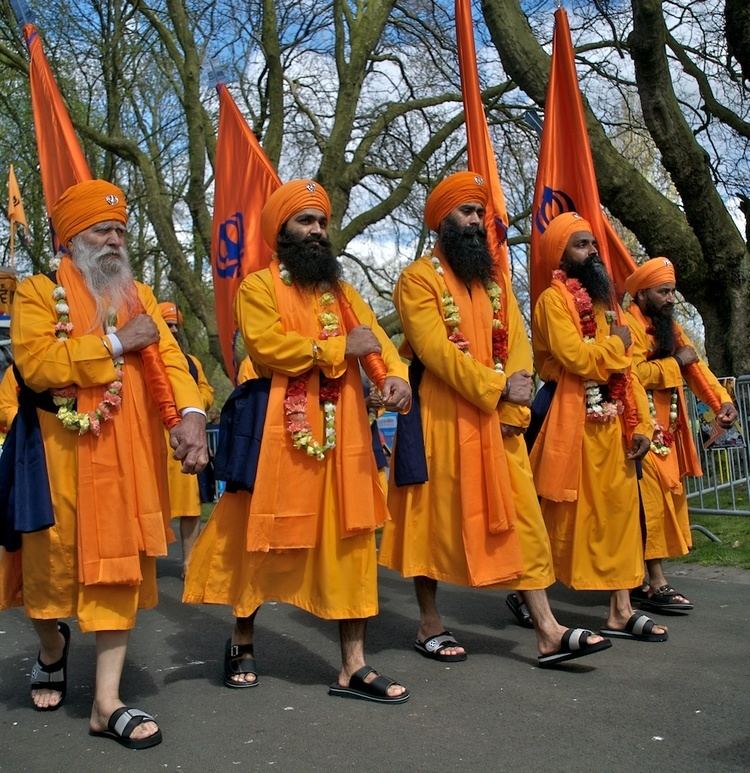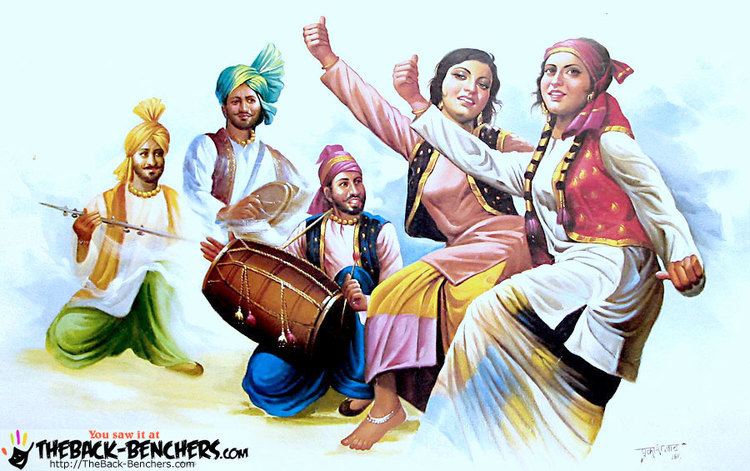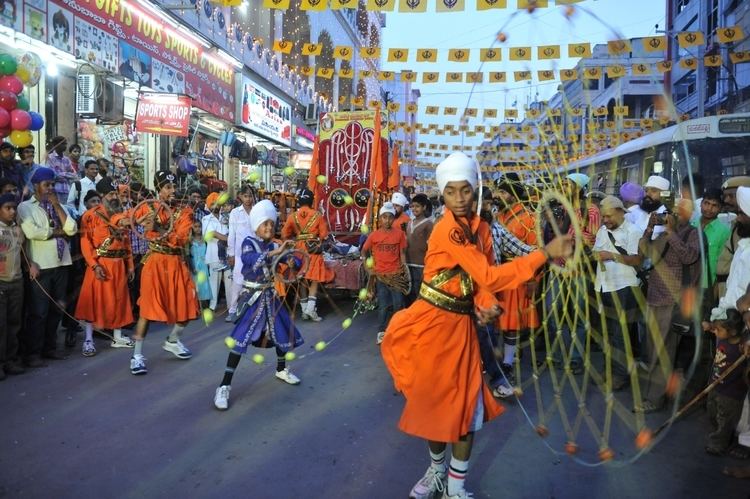Observed by Sikhs, Hindus 2019 date Sat, 13 April Type of holiday Punjabi festival | 2018 date Fri, 13 April 2017 Date 14 April 2017 Also called Baisakh, Vaisakh | |
 | ||
Observances Prayers, processions, raising of the Nishan Sahib flag Featured in religions Sikhism, Hinduism, Buddhism Celebrations Parades and Nagar Kirtan, Fairs, Amrit Sanchaar (baptism) for new Khalsa Significance Sikh New Year, Harvest festival, birth of the Khalsa | ||
Vaisakhi festival kelowna 2016
Vaisakhi (Punjabi: ਵਿਸਾਖੀ, IAST: visākhī), also known as Baisakhi, Vaishakhi, or Vasakhi is a historical and religious festival in Sikhism. It is usually celebrated on April 13 or 14 every year. Vaisakhi marks the Sikh new year and commemorates the formation of Khalsa panth of warriors under Guru Gobind Singh in 1699. It is additionally a spring harvest festival for the Sikhs.
Contents
- Vaisakhi festival kelowna 2016
- Date
- History
- Sikh New Year
- Nagar Kirtan
- Harvest festival
- Aawat pauni
- Fairs and dances
- Hinduism
- Regional variations
- Bikhoti festival
- Vishu
- Bohag Bihu
- Maha Vishuva Sankranti
- Pahela Baishakh
- Puthandu
- Jurshital in Bihar
- Punjab Pakistan
- In United States Canada and United Kingdom
- In Malaysia
- Spelling of Vaisakhi
- Buddhist Vaisakha
- References

Vaisakhi is an ancient festival of Hindus, marking the Solar New Year and also celebrating the spring harvest. It marks the sacredness of rivers in Hindu culture, it is regionally known by many names, but celebrated in broadly similar ways.

Vaisakhi observes major events in the history of Sikhism and the Indian subcontinent that happened in the Punjab region. The significance of Vaisakhi as a major Sikh festival marking the birth of Sikh order started after the persecution and execution of Guru Tegh Bahadur for refusing to convert to Islam under the orders of the Mughal Emperor Aurangzeb. This triggered the coronation of the tenth Guru of Sikhism and the historic formation of Khalsa, both on the Vaisakhi day. Vaisakhi was also the day when colonial British empire officials committed the Jallianwala Bagh massacre on a gathering, an event influential to the Indian movement against colonial rule.

On Vaisakhi, Gurdwaras are decorated and hold kirtans, Sikhs visit and bathe in lakes or rivers before visiting local Gurdwaras, community fairs and nagar kirtan processions are held, and people gather to socialize and share festive foods. For many Hindus, the festival is their traditional solar new year, a harvest festival, an occasion to bathe in sacred rivers such as Ganges, Jhelum and Kaveri, visit temples, meet friends and party over festive foods. This festival in Hinduism is known by various regional names.

Date

Vaisakhi is traditionally observed on 13 or 14 April, every year. The festival is important to both Sikhs and Hindus. The festival coincides with other new year festivals celebrated on the first day of Vaisakh in other regions of the Indian Subcontinent such as Pohela Boishakh, Bohag Bihu, Vishu, Puthandu among others.
History
Vaisakhi is one of the three Hindu festivals chosen by Guru Amar Das to be celebrated by Sikhs (the others being Maha Shivaratri and Diwali).
Each Sikh Vaisakhi festival is, in part, a remembrance of the birth of Sikh order which started after the ninth Guru Tegh Bahadur was persecuted and then beheaded under the orders of the Mughal Emperor Aurangzeb, after he stood up for freedom of religious practice and refused to convert to Islam. The Guru's martyrdom triggered the coronation of the tenth and last Guru of Sikhism, and the formation of the sant-sipahi group of Khalsa, both on the Vaisakhi day.
The Vaisakhi festival Khalsa tradition started in the year 1699, as it is on this day that the 10th Guru of the Sikhs, Guru Gobind Singh laid down the foundation of the Panth Khalsa, that is the Order of the Pure Ones, by baptizing Sikh warriors to defend religious freedoms. This gave rise to the Vaisakhi or Baisakhi festival being observed as a celebration of Khalsa panth formation and is also known as Khalsa Sirjana Divas and Khalsa Sajna Divas. The festival is celebrated on Vaisakhi day (typically 14 April), since 1699. The Birth of the Khalsa Panth was either on 13 April 1699 or 30 March 1699. Since 2003, the Sikh Gurdwara Prabhandak Committee named it Baisakh (Vaisakh), making the first day of the second month of Vaisakh according to its new Nanakshahi calendar.
A special celebration takes place at Talwandi Sabo (where Guru Gobind Singh stayed for nine months and completed the recompilation of the Guru Granth Sahib), in the Gurudwara at Anandpur Sahib the birthplace of the Khalsa, and at the Golden Temple in Amritsar.
Sikh New Year
Vaisakhi has been the traditional Sikh New Year. According to the Khalsa sambat, the Khalsa calendar starts from the day of the creation of the Khalsa- 1 Vaisakh 1756 Bikrami (30 March 1699). It is observed throughout the Punjab region.
Nagar Kirtan
Sikhs communities organize processions called nagar kirtan (literally, "town hymn singing"). These are led by five khalsa who are dressed up as Panj Piaras, and the processions through the streets. The people who march sing, make music, chant hymns from the Sikh texts. Major processions also carry a copy of the Guru Granth Sahib in reverence.
Harvest festival
Vaisakhi is a harvest festival for people of the Punjab region. In the Punjab, Vaisakhi marks the ripening of the rabi harvest. Vaisakhi also marks the Punjabi new year. This day is observed as a thanksgiving day by farmers whereby farmers pay their tribute, thanking God for the abundant harvest and also praying for future prosperity. The harvest festival is celebrated by Sikhs and Punjabi Hindus. Historically, during the early 20th century, Vaisakhi was a sacred day for Sikhs and Hindus and a secular festival for all Muslims and non-Muslims including Punjabi Christians. In modern times, sometimes Christians participate in Baisakhi celebrations along with Sikhs and Hindus.
Aawat pauni
Aawat pauni is a tradition associated with harvesting, which involves people getting together to harvest the wheat. Drums are played while people work. At the end of the day, people sing dohay to the tunes of the drum.
Fairs and dances
The harvest festival is also characterized by the folk dance, Bhangra which traditionally is a harvest dance.
Fairs or Melas are held in many parts of Punjab, India to mark the new year and the harvesting season. Vaisakhi fairs take place in various places, including Jammu City, Kathua, Udhampur, Reasi and Samba, in the Pinjore complex near Chandigarh, in Himachal Pradesh cities of Rewalsar, Shimla, Mandi and Prashar Lakes.
Hinduism
The first day of Vaisakh marks the traditional solar new year and it is an ancient festival that predates the founding of Sikhism. The harvest is complete and crops ready to sell, representing a time of plenty for the farmers. Fairs and special thanksgiving pujas (prayers) are common in the Hindu tradition.
The first day of Vaisakh marks the solar new year. It is the New Year's Day for Hindus in Tamil Nadu, Kerala, Odisha, West Bengal, Assam, Bihar, Uttrakhand, Uttar Pradesh, Himachal Pradesh, Haryana, Punjab and other parts of India. However, this is not the universal new year for all Hindus. For some, such as those in and near Gujarat, the new year festivities coincide with the five day Diwali festival. For others, the new year falls on Ugadi, Gudi Padwa and Cheti Chand, which falls a few weeks earlier.
It is regionally known by many names among the Hindus, though the festivities and its significance is similar. It is celebrated by Hindus bathing in sacred rivers, as they believe that river goddess Ganges descended to earth on Vaisakhi. Some rivers considered particularly sacred include the Ganges, Jhelum and Kaveri. Hindus visit temples, meet friends and party over festive foods.
Vaisakhi coincides with the festival of 'Vishu' celebrated in Kerala a day after Vaisakhi. The festivities include fireworks, shopping for new clothes and interesting displays called 'Vishu Kani'. Hindus make arrangements of flowers, grains, fruits which friends and family visit to admire as "lucky sight" (Vishukkani). Giving gifts to friends and loved ones, as well as alms to the needy are a tradition of Kerala Hindus on this festive day.
Vaisakhi is celebrated as Vaisakhadi in West Bengal and Bahag Bihu in Assam, but typically one or two days after Vaisakhi. The community organizes procession, feasts, music, and dancing.
Regional variations
The following is a list of new year festivals:
The new year falls on or about the same day every year for many Buddhist communities in parts of South and Southeast Asia. This is likely an influence of their shared culture in the 1st millennium CE. Some examples include:
Bikhoti festival
The Bikhoti Festival of Uttrakhand involves people taking a dip in holy rivers. A popular custom involves beating symbolic stones representing demons with sticks. The fair is celebrated in various major centres including Sealdah, Bageshwar and Dwarahat and involves much singing and dancing, accompanied by local drums and other instruments.
Vishu
Vishu is the Hindu new year festival celebrated on the same day as Vaisakhi in the Indian state of Kerala, and falls on the first day of Malayali month called Medam. The festival is notable for its solemnity and the general lack of pomp and show that characterize other Hindu festivals of Kerala such as Onam.
The festival is marked by family time, preparing colorful auspicious items and viewing these as the first thing on the Vishu day. In particular, Malayali Hindus seek to view the golden blossoms of the Indian laburnum (Kani Konna), money or silver items (Vishukkaineetam), and rice. The day also attracts firework play by children, wearing new clothes (Puthukodi) and the eating a special meal called Sadya, which is a mix of salty, sweet, sour and bitter items. The Vishu arrangement typically includes an image of Vishnu, typically as Krishna. People also visit temples on the day.
Bohag Bihu
Bohag Bihu or Rangali Bihu marks the beginning of the Assamese New Year on April 13. It is celebrated for seven days Vishuva Sankranti (Mesha Sankranti) of the month of Vaisakh or locally 'Bohag' (Bhaskar Calendar). The three primary types of Bihu are Rongali Bihu, Kongali Bihu, and Bhogali Bihu. Each festival historically recognizes a different agricultural cycle of the paddy crops. During Rangali Bihu there are 7 pinnacle phases: 'Chot', 'Raati', 'Goru', 'Manuh', 'Kutum', 'Mela' and 'Chera'.
Maha Vishuva Sankranti
Maha Vishuva Sankranti marks the Oriya new year in Odisha. Celebrations include various types of folk and classical dances, such as the Shiva-related Chhau dance.
Pahela Baishakh
The Bengali new year is celebrated as Pahela Baishakh on April 14 every year, and a festive Mangal Shobhajatra is organized in West Bengal, Tripura and Bangladesh. This celebration was listed in 2016 by the UNESCO as a cultural heritage of humanity.
The festival is celebrated as a national holiday in Bangladesh. Also spelled Pohela Boishakh is also known as Nobo Barsho as it is the first day of the Bengali month of Bongabdo. Fairs are organised to celebrate the event which provide entertainment including the presentation of folk songs.
Puthandu
Puthandu, also known as Puthuvarusham or Tamil New Year, is the first day of the month Chithirai on the Tamil calendar.
On this day, Tamil people greet each other by saying "Puttāṇṭu vāḻttukkaḷ!" or "Iṉiya puttāṇṭu nalvāḻttukkaḷ!", which is equivalent to "Happy new year". The day is observed as a family time. Households clean up the house, prepare a tray with fruits, flowers and auspicious items, light up the family Puja altar and visit their local temples. People wear new clothes and youngster go to elders to pay respects and seek their blessings, then the family sits down to a vegetarian feast.
Jurshital in Bihar
In the Mithal region of Bihar and Nepal, the new year is celebrated as Jurshital. It is traditional to use lotus leaves to serve sattu (powdered meal derived from grains of red gram and jau (Hordeum vulgare) and other ingredients) to the family members.
Punjab (Pakistan)
Pakistan has many sites that are of historic importance to the Sikh faith, such as the birth place of Guru Nanak. These sites attract pilgrims from India and abroad every year on Vaisakhi.
According to Aziz-ud-din Ahmed, Lahore used to have Baisakhi Mela after the harvesting of the wheat crop in April. However, adds Ahmed, the city started losing its cultural vibrancy in 1970s after Zia-ul-Haq came to power, and in recent years "the Pakistan Muslim League (N) government in Punjab banned kite flying through an official edict more under the pressure of those who want a puritanical version of Islam to be practiced in the name of religion than anything else". Unlike the Indian state of Punjab that recognizes the Vaisakhi Sikh festival as an official holiday, the festival is not an official holiday in Punjab or Sindh provinces of Pakistan where Islamic holidays are officially recognized instead. On 8th April 2016, Punjabi Parchar at Alhamra (Lahore) organised a show called Visakhi mela, where the speakers pledged to "continue our struggle to keep the Punjabi culture alive" in Pakistan through events such as Visakhi Mela.
Pakistan used to have many more Sikhs, but a vast majority moved to India during the 1947 India-Pakistan partition. Contemporary Pakistan has about 20,000 Sikhs in a total population of about 200 million Pakistanis, or about 0.01%. These Sikhs, and thousands more arrive from other parts of the world for pilgrimage, observe Vaisakhi in Western Punjab (Pakistan) with festivities centered on the Panja Sahib complex in Hasan Abdal, Gurudwaras in Nankana Sahib, and in various historical sites in Lahore.
In United States, Canada, and United Kingdom
In the United States, there is usually a parade commemorating the Vaisakhi celebration. In Manhattan, New York City people come out to do "Seva" (selfless service) such as giving out free food, and completing any other labor that needs to be done. In Los Angeles, California, the local Sikh community consisting of many Gurdwaras holds a full day Kirtan (spiritual music) program followed by a parade. The local Sikh community in Vancouver, Abbotsford and Surrey, British Columbia, Canada holds its annual Vaisakhi celebrations in April, which often includes a Nagar Kirtan (parade) with the parade is Surrey involving 200,000 people in 2014.
The United Kingdom has a large Sikh community originating from the Indian sub-continent, East Africa and Afghanistan. The largest concentrations of Sikhs in the UK are to be found in the West Midlands (especially Birmingham and Wolverhampton) and London. The Southall Nagar Kirtan is held on a Sunday a week or two before Vaisakhi. The Birmingham Nagar Kirtan is held in late April in association with Birmingham City Council, and it is an annual event attracting thousands of people which commences with two separate nagar kirtans setting off from gurdwaras in the city and culminating in the Vaisakhi Mela at Handsworth Park.
In Malaysia
The Sikh community, a subgroup of the Malaysian Indian ethnic minority race, is an ethnoreligious minority in Malaysia, which is why Vaisakhi is not a public holiday. However, in line with the government's efforts to promote integration among the country's different ethnic and religious groups, the prime minister, Najib Razak has announced that beginning 2013, all government servants from the Sikh Malaysian Indian community will be given a day off on Vaisakhi Day. Vaisakhi 'open houses' are also held across the country during the day of the festival, or the closest weekend to it.
Spelling of Vaisakhi
The spelling varies with region. In Punjab region, Vaisakhi is common, while in the Doabi and Malwai regions, it is common for speakers to substitute a "B" for a "V". Therefore, the spelling used is dependent on the dialect of the writer.
Buddhist Vaisakha
A similarly spelled historic festival is celebrated in Indian subcontinent, East Asia and Southeast Asia as the Buddha's birthday, called the festival of Vaisakha, also known as Vaisakhi Purnima, Baisakhi Purnima, Vesakha or Vesak. They both derive their name from the lunar month, but Vesakha remembers the Buddha. Considered the most important festival in Buddhism, Vesakha is celebrated in same Indian calendar month of Vaishakha, but typically falls a few weeks after the Sikh and Hindu Vaisakhi.
